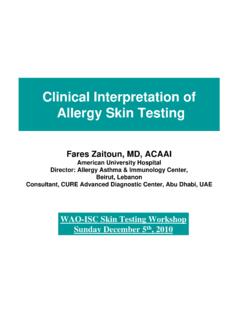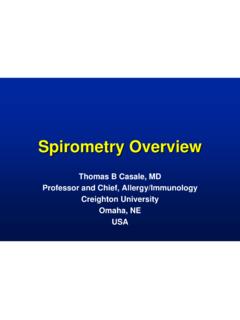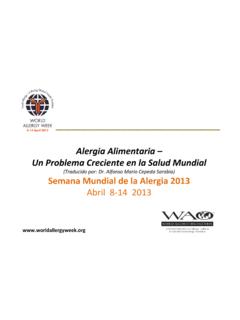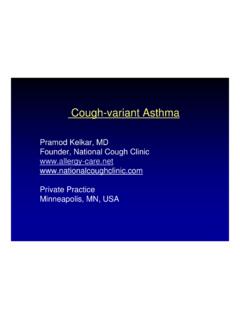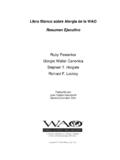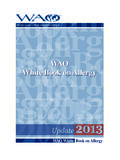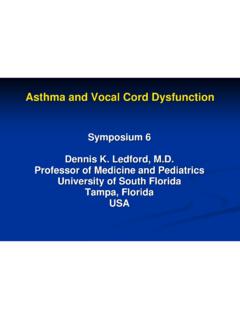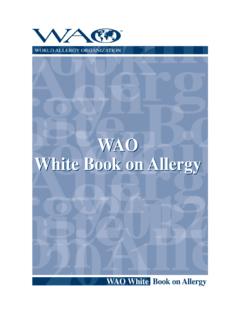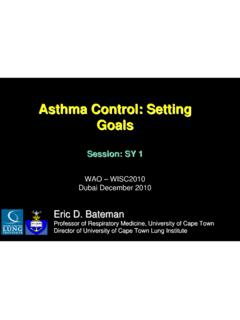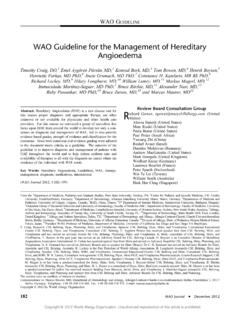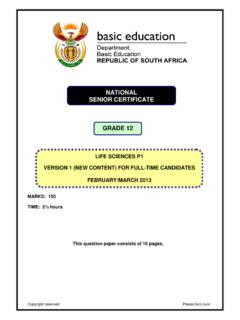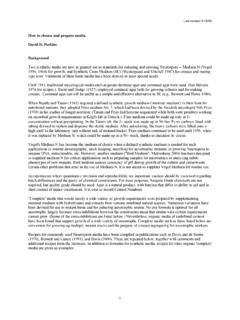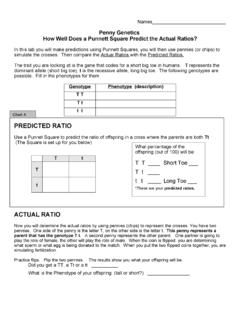Transcription of Defining Phenotypes: Expanding Our …
1 Defining phenotypes : Expanding Our understanding of AsthmaChallenges in Treating a Heterogeneous DiseaseRichard F. Lockey, of Allergy and ImmunologyDepartment of Internal MedicineUniversity of South Florida College of MedicineandJames A. Haley Veterans Medical CenterTampa, FloridaAsthma phenotypes Task ForceNational Heart, Lung, and Blood InstituteNational Institute of Allergy and Infectious DiseasesAmerican Academy of Allergy, Asthma & ImmunologyAmerican Thoracic Society European Respiratory SocietyJames P. Kiley, , Division of Lung Diseases, NHLBIA sthma phenotypes Task Force Goals and ObjectivesAsthma phenotypes Task Force Goals and ObjectivesAsthma Phenotype Task ForceNHLBI, NIAID, AAAAI, ATS, ERS CollaborationElisabeth Bel, Medical Center, AmsterdamHomer Boushey, California, San FranciscoTheresa Guilbert, Wisconsin, MadisonStephen Lazarus, California, San FranciscoRobert Lemanske, Jr.
2 , Wisconsin, MadisonMark Liu, Hopkins UniversityRichard Lockey, South FloridaDavid Mauger, State UniversityStephen Peters, , Forest UniversityLanny Rosenwasser, s Mercy Hospital, Kansas CityMichael Schatz, Permanente, San DiegoSally Wenzel, PittsburghJames Kiley, Taggart, Fenton, Gergen, Plaut, Togias, for Phenotype Definitions Asthma has many distinct phenotypes ( a cluster of characteristics that define a disease and its subsets ) The lack of common phenotype definitions or controlled vocabulary to describe study populations makes it is difficult to interpret & fully use clinical research findings. Asthma Phenotype Task Force GoalCollaboration among NHLBI, NIAID, AAAAI, ATS, and ERS to develop definitions of asthma phenotypes that will: Enhance interpretation of studies Promote appropriate comparisons among studies Facilitate genetics research in which phenotype is correlated with genotypeAsthma Phenotype Task Force Process Define 9 asthma phenotypes Develop controlled vocabulary checklist to describe key characteristics regarding a study population s ;;demography ;;asthma clinical features & comorbidities;;asthma physiology.
3 Asthma biomarkersAsthma phenotypes Define 9 phenotypes in 3 general categories:- Trigger-induced asthma1) Allergic2) Non-allergic3) Aspirin-exacerbated respiratorydisease (AERD)4) Infection5) Exercise-inducedAsthma phenotypes -Clinical presentation of asthma6) Pre-asthma wheezing in infants- Episodic (viral) wheeze- Multi-trigger wheezing7) Exacerbation-prone asthma8) Asthma associated with apparent irreversible airflow limitation- Inflammatory markers of asthma9) Eosinophilic and neutrophilic asthmaAsthma phenotypes Define 9 phenotypes in 3 general categories:- Trigger-induced asthma1) Allergic2) Non-allergic3) Aspirin-exacerbated respiratorydisease (AERD)4) Infection5) Exercise-inducedAllergic Background Probably the most common phenotype 45;88 % of asthmatic patients in recent studies Higher prevalence in children, but 60;75 % prevalence in elderly in two recent studies Defined based on sensitization clinical correlationAllergic Proposed Definition Sensitization (Required) At least one positive prick puncture or in vitro test for specific IgE Antigens: local pollens, mite, Alternaria, Aspergillus, Cladosporium, cat, dog, roach Clinical correlation (Desirable).
4 One or more of the following: Perennial with sensitization and exposure Seasonal symptoms Symptoms with exposure to grass, dust, cats, dogsAllergic Asthma: Demographic and Clinical Characteristics Younger patients and onset at earlier age than non-allergic More common in males Family history of allergies common Seasonal variation more common than non-allergic Severity data conflicting Exercise-symptoms more frequent and severe than non-allergicAllergic Asthma: Clinical Information Needed to Support Definition Sensitization (prick puncture skin tests or in vitro tests for specific IgE) Age of onset Perennial versus seasonal symptoms Allergic rhinoconjunctivitis symptoms Allergy triggers (grass, dust, cat, dog)Asthma phenotypes Define 9 phenotypes in 3 general categories:- Trigger-induced asthma1) Allergic2) Non-allergic3) Aspirin-exacerbated respiratorydisease (AERD)4) Infection5) Exercise-inducedNon;Allergic AsthmaBackground Asthma risk increases with increased IgE levels Most asthmatics are atopic However, non;allergic, intrinsic asthma phenotype long recognizedQuestions How should phenotype be defined?
5 Is this phenotype clinically useful?Non;Allergic Asthma Definition Asthma in patients in whom allergic sensitization cannot be demonstrated Negative skin prick or RAST testing to a panel of seasonal and perennial allergens: Local pollens (grass, tree, weed), molds (Alternaria, Aspergillus, Cladosporium), house dust mite (Dermatophagoides farinae, D. pteronyssinus), cockroach, cat, dog Minimum panel: Perennial allergens Normal or low IgENon;Allergic Asthma: Demographic and Clinical Characteristics Onset: Late, adult Gender: Female predominance Incidence: 10;33% No personal or family history of allergy Lack of seasonal or exposure;related triggers Symptoms: perennial, sometimes beginning with severe respiratory tract infection Severity: More severe than allergic asthma, less responsive to steroids Aspirin;sensitive asthma often includedAsthma phenotypes Define 9 phenotypes in 3 general categories:; Trigger;induced asthma1) Allergic2) Non;allergic3) Aspirin;exacerbated respiratorydisease (AERD)4) Infection5) Exercise.
6 InducedAspirin-Exacerbated Respiratory Disease (AERD) Aspirin triad Sampter s triad Aspirin-sensitive asthmaAERD Background1. Prevalence by history is variable (3;5%) but may be present in up to 21% of adults and 5% of children in certain populations with asthma when determined by oral provocative In a study of 300 patients in the United States, 57% of patients with aspirin;sensitive asthma were female. In a European study, females outnumbered males :1. 3. Usual age of onset of symptoms is 30;34 years of No known racial No known association with lower socioeconomic status. AERD Task Force Proposed Definition DEFINITE CRITERION:Documented asthmatic response toaspirin or other non;steroidal anti;inflammatory drug(s)AERD Task Force Proposed Definition (cont d)PROBABLE CRITERIA, WHENHISTORY OF ASPIRIN SENSITIVITYIS ABSENT IN A SUBJECT WITHASTHMA: Chronic rhinosinusitis with nasal polyps Adult onset (over age 20 years) Peripheral blood eosinophiliaAERD Genetics1.
7 Familial cases reported but relatively rare ( ).2. Association with HLA;DQw2 and Genetic polymorphisms found in leukotriene C4synthase (LTC4S), 5;lipoxygenase (5;LO), cyclooxygenase;1 (COX;1), cyclooxygenase;2 (COX;2), prostaglandin E2 receptor Clinical Features 1. Associated with more severe, refractory asthma, representing a major risk factor for severe asthma in ASA may induce severe, life;threatening asthma Rhinorrhea and nasal congestion are usually the first symptoms of aspirin;sensitive asthma and are commonly poorly responsive to pharmacological Clinical Features (cont d)4. Anosmia is Asthma and aspirin sensitivity become apparent 1;5 years after initial onset of upper respiratory Symptoms manifest within 1;3 hours of ingestion of aspirin and other COX;1 Refractory period to ASA and other COX;1 inhibitors is 2;5 days after ASA phenotypes Define 9 phenotypes in 3 general categories:; Trigger;induced asthma1) Allergic2) Non;allergic3) Aspirin;exacerbated respiratory disease (AERD)4) Infection5) Exercise;inducedInfection.
8 Induced Asthma:Definition An individual in which a respiratory tract infectioninfluences his/her asthma in any one of the following ways: Associated with new onset of disease (in both children and adults) Associated with exacerbationsof the disease Only mechanism of exacerbation One of a number of exacerbating factors Infection;induced exacerbations may be severe in nature Co;morbid condition ( sinusitis) may influence asthma control Associated with persistence and/or severity of the disease Infection;Induced Asthma: Infectious Agents Responsible New onset Respiratory syncytial virus (RSV) Rhinovirus Parainfluenza Metapneumovirus Exacerbations Rhinovirus RSV Influenza/parainfluenza Coronaviruses Persistence/chronicity Adenovirus Chlamydia MycoplasmaInfection;Induced Asthma: Histopathology and Biomarkers Neutrophil infiltrate acutely; enhanced airway eosinophilia chronically ?
9 Defect in asthmatic epithelial cells that permits viral replication as opposed to apoptosis P. A. Wark et al. (6):937;947, phenotypes Define 9 phenotypes in 3 general categories:; Trigger;induced asthma1) Allergic2) Non;allergic3) Aspirin;exacerbated respiratorydisease (AERD)4) Infection5) Exercise;inducedBackgroundExercise;Induc ed Asthma Most patients with asthma will develop EIB if they perform sufficient exercise to reach 80;85% of maximum predicted heart rate. EIB has been described in 7;20% of the general population. EIB is sometimes (incorrectly) thought of as a unique form of asthma, when it is seen in subjects whose disease is so mild ( mild intermittent ), that they experience bronchoconstriction only when they exercise.
10 However, it can be seen in subjects of all ages and severities, correlating best with degree of bronchial ;Induced Asthma No apparent gender disparity No known racial predisposition No known association with socioeconomic status No known association with smoking Exercise;Induced Bronchospasm:Definition Exercise;induced asthma (EIA) refers to the airway narrowing and resultant decrease in expiratory air flow that occurs following vigorous exercise. The term EIA is inaccurate, as exercise induces an asthma attack, not asthma. A more precise term, gaining in acceptance, is exercise;induced bronchoconstriction (EIB). Exercise;Induced Bronchospasm:Definition It can be demonstrated in most asthmatics if they exercise to a sufficiently high work load and in a small percentage of non;asthmatic subjects.
